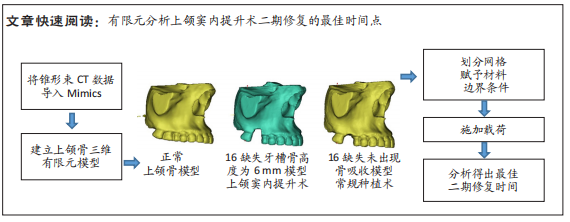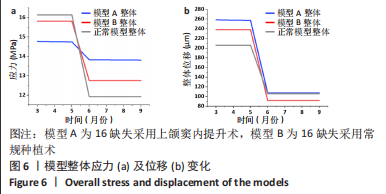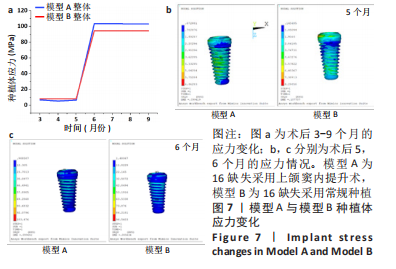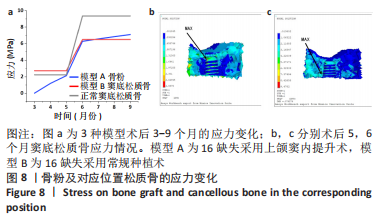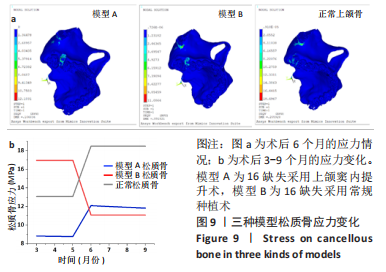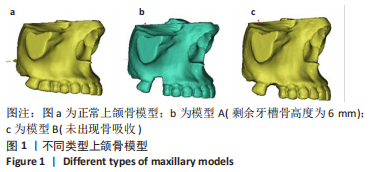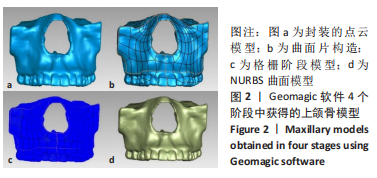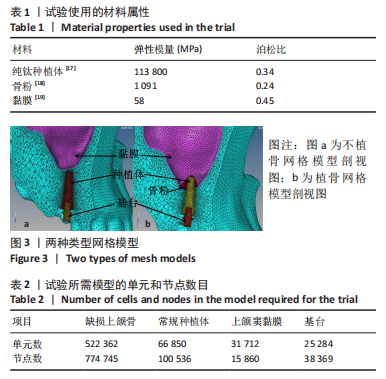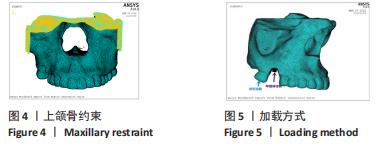[1] HADZIK J, KUBASIEWICZ-ROSS P, NAWROT-HADZIK I, et al. Short (6 mm) and Regular Dental Implants in the Posterior Maxilla–7-Years Follow-up Study. J Clin Med. 2021;10(5):940.
[2] 王璨, 顾卫平, 朱琳, 等. All-on-4与穿颧种植在不同皮质骨厚度中的生物力学研究[J]. 口腔医学,2021,41(8):685-691.
[3] 郭海波, 汤春波, 周储伟, 等. 上颌无牙颌固定修复中5颗不同倾斜角度种植体的三维有限元分析[J]. 口腔医学,2020,40(10):894-899.
[4] DONATAS B, GAILĖ B. Short implants without bone augmentation versus long implants with bone augmentation. Systematic review and meta-analysis. Aust Dent J. 2021;66 Suppl 1:S71-S81.
[5] STARCHJENSEN T, AHMAD M, BRUUN NH, et al. Patient’s perception of recovery after maxillary sinus floor augmentation with autogenous bone graft compared with composite grafts: a single-blinded randomized controlled trial. Int J Implant Dent. 2021;7(1):99.
[6] CAPATTI RS, BARBOZA MS, DA GAMA ANTUNES AN,et al. Viability of Maxillary Single Crowns Supported by 4-mm Short Implants: A Finite Element Study. Int J Oral Maxillofac Implants. 2020;35(3):e41-e50.
[7] BORDIN D, CASTRO MB, CARVALHO MA,et al. Different Treatment Modalities Using Dental Implants in the Posterior Maxilla:A Finite Element Analysis. Braz Dent J. 2021;32(1):34-41.
[8] MIKIC M, VLAHOVIC Z, STEVANOVIĆ M, et al. The Importance of Correlation between CBCT Analysis of Bone Density and Primary Stability When Choosing the Design of Dental Implants—Ex Vivo Study. Tomography. 2022;8(3):1293-1306.
[9] SUMMERS RB.A new concept in maxillary implant surgery: the osteotome technique. Compendium (Newtown, Pa.). 1994;15(2):152.
[10] TOFFLER M. Osteotome-mediated sinus floor elevation: a clinical report. Int J Oral Maxillofac Implants. 2004;19(2):266-273.
[11] FANALI S, TUMEDEI M, PIGNATELLI P, et al. The Effect of Threads Geometry on Insertion Torque (IT) and Periotest Implant Primary Stability: A High-Density Polyurethane Simulation for the Anterior Mandible. Crystals. 2021;11(3):308.
[12] OHBA S, SHIDO R, ASAHINA I.Application of hydroxyapatite/collagen composite material for maxillary sinus floor augmentation. J Oral Sci. 2021;63(3):295-297.
[13] FUJITA A,FUKUMOTO C,HASEGAWA T,et al.Morphometric and histomorphometric evaluations of high-purity macro/microporous beta-tricalcium phosphate in maxillary sinus floor elevation: preliminary results on a retrospective, multi-center, observational study. BMC Oral Health. 2021;21(1):448.
[14] 王野平, 林小英, 周慧峰. Mimics和Geomagic辅助下建立固定义齿的有限元模型[J].医用生物力学,2010,25(6):433-438.
[15] TURLYBEKULY A, POGREBNJAK AD, SUKHODUB LF, et al. Synthesis, characterization, in vitro biocompatibility and antibacterial properties study of nanocomposite materials based on hydroxyapatite-biphasic ZnO micro- and nanoparticles embedded in Alginate matrix. Mater Sci Eng C Mater Biol Appl. 2019;104:109965.
[16] SHOUEIR K, AHMED MK, ABDEL GABER SA, et al. Thallium and selenite doped carbonated hydroxyapatite: Microstructural features and anticancer activity assessment against human lung carcinoma. Ceram Int. 2020;46(4):5201-5212.
[17] CANTÓ-NAVÉS O, MEDINA-GALVEZ R, MARIMON X, et al. A 3D Finite Element Analysis Model of Single Implant-Supported Prosthesis under Dynamic Impact Loading for Evaluation of Stress in the Crown, Abutment and Cortical Bone Using Different Rehabilitation Materials. Materials. 2021;14(13):3519.
[18] 刘晓芳, 胡玲玲, 宋光保, 等. 3种提升材料对闭合式上颌窦底提升术上颌窦黏膜形变影响的力学分析[J]. 实用口腔医学杂志,2014(6):831-834.
[19] 薛燕青, 毓天昊, 郑添予, 等. 种植体根尖部与上颌窦底皮质骨的关系对上颌后牙区种植影响的三维有限元分析[J].中国实用口腔科杂志,2018,11(1): 24-28.
[20] 曹敏, 王冬梅, 王明一, 等. 半侧上颌骨缺损赝复体修复固位方案的生物力学评价[J]. 医用生物力学,2013,28(5):484-489.
[21] 丁光兴. 基于个性化的长管骨有限元参数化建模及实验验证[D].南京:南京理工大学,2012.
[22] 关振群, 石俊, 李爱群, 等. Mimics辅助快速建立颅上颌复合体的三维有限元模型[J]. 中国组织工程研究与临床康复,2011,15(43):7998-8001.
[23] SACHIN C, VRUSHALI T, RITU C, et al. The rehabilitation of posterior atrophic maxilla by using the graftless option of short implant versus conventional long implant with sinus graft: A systematic review and meta-analysis of randomized controlled clinical trial. JIPS. 2021;21(1):28-44.
[24] HORITA S, SUGIURA T, YAMAMOTO K, et al. Biomechanical analysis of immediately loaded implants according to the “All-on-Four” concept.J Prosthodont Res. 2017; 61(2):123-132.
[25] KITAMURA E,STEGAROIU R,NOMURA S, et al.Influence of marginal bone resorption on stress around an implant - a three-dimensional finite element analysis. J Oral Rehabil. 2005;32(4):279-286.
[26] YANBO J, MING G, DONGHUI C, et al. Maxillary sinus pneumatization and augmentation: A three-dimensional finite element analysis. Mater Express. 2021;11(11):1892-1900.
[27] 刘磊, 陈斌科.不同提升法在上颌窦底提升术同期种植中的应用观察[J].浙江创伤外科,2022,27(1):71-73.
[28] ERCAL P, TAYSI AE, AYVALIOGLU DC, et al.Impact of peri-implant bone resorption, prosthetic materials, and crown to implant ratio on the stress distribution of short implants: a finite element analysis. Med Biol Eng Comput. 2021;59(4):813-824.
[29] WANG X, ZHANG T, YANG E, et al.Biomechanical Analysis of Grafted and Nongrafted Maxillary Sinus Augmentation in the Atrophic Posterior Maxilla with Three-Dimensional Finite Element Method. Scanning. 2020;2020:8419319.
[30] RUES S,LENZ JR,SCHIERLE HP,et al.Simulation of the sinus floor elevation. PAMM. 2004;4(1):368-369.
[31] 李男男, 张茹慧, 周延民.骨挤压上颌窦提升术中骨挤压器距上颌窦底不同距离的三维有限元分析[J].临床口腔医学杂志,2006,22(7):407-410.
|
